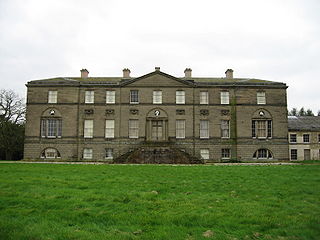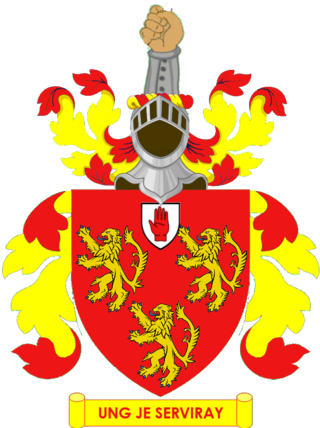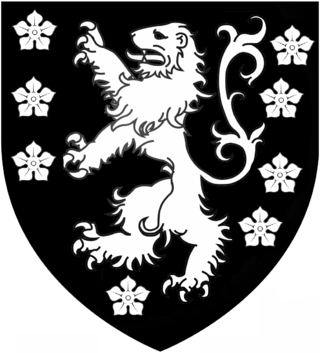Baron Wrottesley, of Wrottesley in the County of Stafford, is a title in the Peerage of the United Kingdom. It was created on 11 July 1838 for Sir John Wrottesley, 9th Baronet. He was a Major-General in the Army and also represented Lichfield, Staffordshire and Staffordshire South in House of Commons. The Wrottesley family's original patronymic was 'de Verdun', which meant that the creation of the title Baron Wrottesley represented the third barony created by a branch of the de Verdun family in England. The other two were established by Theobald de Verdun, 1st Baron Verdun of Alton Castle and Sir John de Verdon, 1st Baron Verdon, lord of Brixworth in Northamptonshire and Bressingham in Norfolk.

The Broughton, later Broughton-Delves, later Broughton Baronetcy, of Broughton in the County of Stafford, is a title in the Baronetage of England. It was created on 10 March 1661 for Sir Brian Broughton, of Broughton Hall, near Eccleshall, Staffordshire, High Sheriff of Staffordshire from 1660 to 1661 and the member of an ancient Staffordshire family.

The Smith, later Smyth, Smijth, Bowyer-Smijth and Bowyer-Smyth Baronetcy, of Hill Hall in the County of Essex, was created on 28 November 1661 for Thomas Smith. The current holder is the fifteenth Baronet.

There have been twenty one baronetcies created for persons with the surname Williams, eight in the Baronetage of England, three in the Baronetage of Great Britain and ten in the Baronetage of the United Kingdom. Only six of the creations are extant as of 2017.
Robert de Stafford was an Anglo-Norman nobleman, the first feudal baron of Stafford in Staffordshire in England, where he built as his seat Stafford Castle. His many landholdings are listed in the Domesday Book of 1086.

Overseal is a village and civil parish in South Derbyshire district of Derbyshire, England. It is 3 miles (4.8 km) south of Swadlincote, 5 miles (8.0 km) west of Ashby-de-la-Zouch and 13 miles (21 km) south-southwest of Derby. It had a population of the civil parish at the 2011 census was 2,450. Situated within the National Forest area, it is near the villages of Netherseal and Lullington as well as being close to the border with Leicestershire. It is one of the southernmost settlements in Derbyshire.
Sir John Edensor Heathcote, was a Stoke-on-Trent industrialist and owner of Longton Hall in Longton, Staffordshire which he rebuilt in 1778.
This is a list of the sheriffs and high sheriffs of Staffordshire.

The Chetwynd Baronetcy, of Brocton Hall in the County of Stafford, is a title in the Baronetage of Great Britain. It was created on 1 May 1795 for Sir George Chetwynd, Kt., of Brocton Hall, Staffordshire, for many years Clerk to the Privy Council. The second Baronet was a member of parliament for Stafford and High Sheriff of Warwickshire in 1828. The fourth Baronet served as High Sheriff of Warwickshire in 1875. As of 13 June 2007, the presumed ninth Baronet has not successfully proven his succession and is therefore not on the Official Roll of the Baronetage, with the Baronetcy dormant since 2004.

The FitzHerbert baronetcy, of Tissington in the County of Derby, is a title in the Baronetage of Great Britain. It was created on 22 January 1784 for William FitzHerbert, of Tissington Hall, Derbyshire.

The Every Baronetcy, of Egginton in the County of Derby, is a title in the Baronetage of England. It was created on 26 May 1641 for Simon Every, Member of Parliament for Leicester in 1640 and a supporter of the Royalist cause in the Civil War. Born into the Every family of Dorset and Somerset, and a cousin to the Brice family of Somerset, he married Anne, daughter and co-heir of Sir Henry Leigh, of Egginton, Derbyshire. After his marriage, Every settled at Egginton.

There have been two baronetcies created for persons with the surname Goring, both in the Baronetage of England. The second creation came into the family through a special remainder in the patent creating the baronetcy. Only the latter creation is extant as of 2008.

There have been three baronetcies created for persons with the surname Cooke, two in the Baronetage of England and one in the Baronetage of Ireland. One creation is extant as of 2013.
Sir Roger Gresley, 8th Baronet was an English author and Tory politician who sat in the House of Commons from 1835 to 1837.

Sir Nigel Gresley, 6th Baronet was an English land-owner, mine-owner, and canal builder. Born into the Gresley family of Staffordshire, he enrolled at an early age in the Royal Naval Academy. He served in the Royal Navy for eight years, attaining the rank of lieutenant, before his career was cut short due to rheumatic issues. In 1753 he inherited his brother's baronetcy, and became owner of estates at Drakelow and Knypersley. As part of these he owned several mines at Apedale, and in 1775 he obtained an Act of Parliament to build Sir Nigel Gresley's Canal, which was completed in the following year and held a monopoly over Newcastle-under-Lyme coal for forty-two years. He died at Bath, Somerset, in 1787.
Sir Thomas Gresley, 10th Baronet was an English Conservative Party politician who was elected to the constituency of South Derbyshire, but died before he took his seat.

Rev. Thomas Levett served as rector of Whittington, Staffordshire, for 40 years, and as a large landowner in addition to being a clergyman, played a role in the development of Staffordshire's educational system. He was also a member of one of Staffordshire's longest-serving families in ecclesiastical circles, having produced three rectors of the parish of Whittington. The Levett family also produced members of parliament, High Sheriffs of Staffordshire, Lichfield town recorders and businessmen who were friends and contemporaries of Samuel Johnson, Erasmus Darwin, writer Anna Seward, actor David Garrick and other local luminaries. Several streets in Lichfield are named for the family.

Two unrelated baronetcies have been created in the surname of Clifton.
Thomas Gresley may refer to:
Sir George Gresley, 1st Baronet was an English landowner and politician who sat in the House of Commons from 1628 to 1629.













